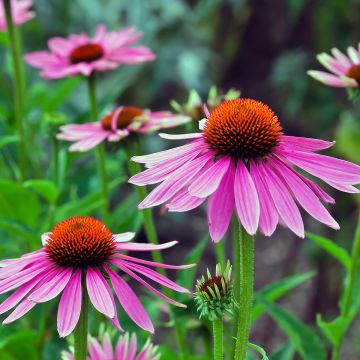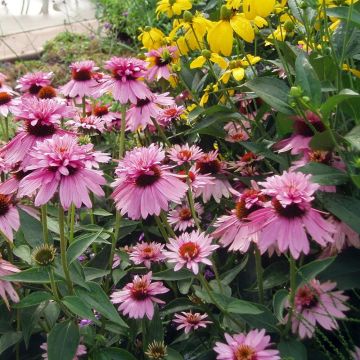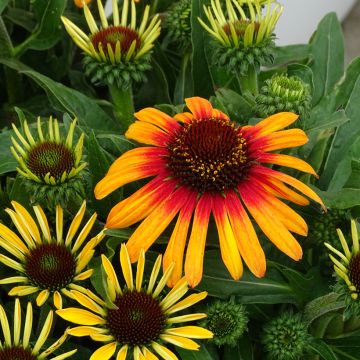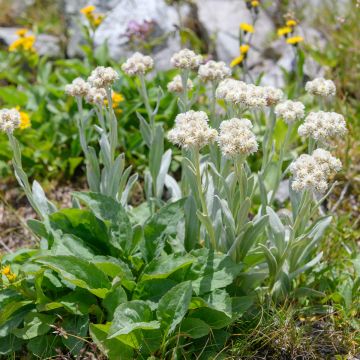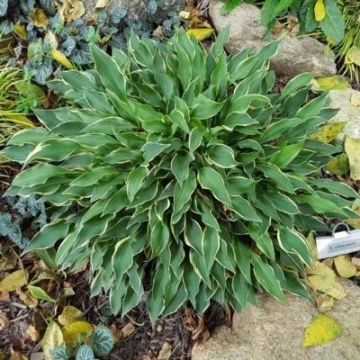

Echinacea Dark Shadows Wicked - Rudbeckia
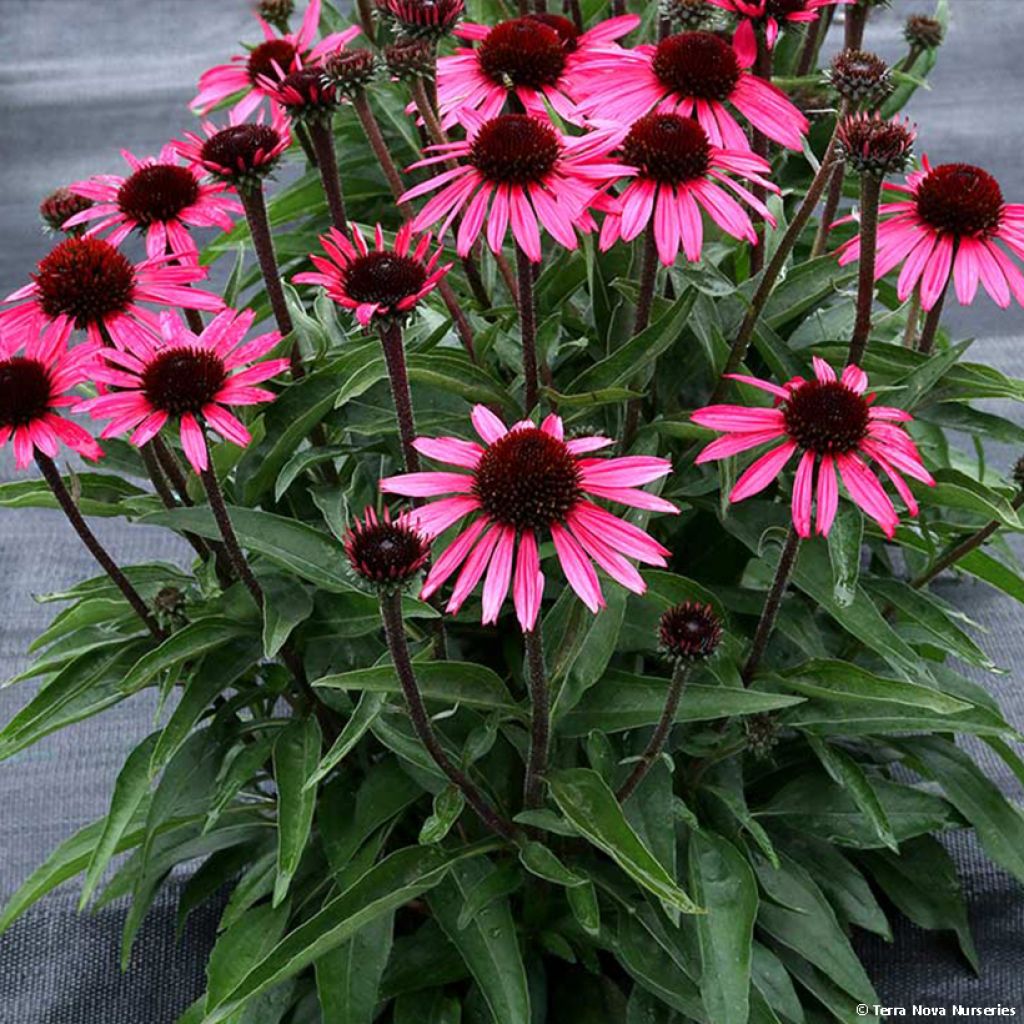

Echinacea Dark Shadows Wicked - Rudbeckia


Echinacea Dark Shadows Wicked - Rudbeckia
Echinacea purpurea Dark Shadows Wicked - Purple Coneflower
Echinacea x purpurea Dark Shadows Wicked
Purple Coneflower, Eastern Purple Coneflower
Why not try an alternative variety in stock?
View all →This plant carries a 12 months recovery warranty
More information
We guarantee the quality of our plants for a full growing cycle, and will replace at our expense any plant that fails to recover under normal climatic and planting conditions.
From €5.90 for pickup delivery and €6.90 for home delivery
Express home delivery from €8.90.
Does this plant fit my garden?
Set up your Plantfit profile →
Description
Echinacea Dark Shadows 'Wicked' is a rather fantastic variety of Echinacea, both in terms of its habit and its colours. This plant, upright and vertical, forms a true bouquet of flowers in a bright watermelon pink colour around a prominent cone in a very dark brown, almost black. They are borne on stems of chocolate brown colour, well above beautiful dark green foliage. An astonishing plant, stunning when planted en masse, magnificent in pots. Not demanding, it adapts to all well-drained soils, in full sun.
Native to the western United States, from Georgia to Michigan via Oklahoma and Ohio, the Echinacea purpurea is a perennial with a strong character that colonizes rocky meadows, savannas, clear undergrowth, and roadside edges in its natural environment. Dark Shadows 'Wicked' is part of a lineage of hybrids recently developed in the USA by Terra Nova Nurseries. This variety also carries the genes of the Echinacea tennesseensis. It forms a dense and upright clump, 40cm (16in) tall when in flower and 35cm (14in) wide. This plant does not weaken, does not collapse, showing very good durability. The opposite leaves, lanceolate in shape and dark green in colour, are gathered towards the base of the stems. The abundant flowering lasts from July to September and is very visited by butterflies. The sturdy, dark stems are topped by a solitary head-like inflorescence. Each of these heads is composed of a prominent central cone, ranging from reddish-brown to almost black, and a collar of horizontal petals or ligules in a beautiful deep pink colour. The fruit is an achene that releases seeds which birds are fond of. This plant anchors itself firmly and deeply in the soil, thanks to its highly developed root system.
Echinacea Dark Shadows 'Wicked' can be grown in pots or in the ground. This perennial can be planted in the borders of flower beds, mixed with other compact varieties of Echinaceas, or in the company of Inulas, compact Tritomas, Achilleas, daisies, Echinops, Coreopsis. Lighten up the scene by mixing in some ornamental grasses such as Stipa tenuifolia, Muhlenbergia capillaris, etc. Splendid in flower beds, the beautiful colours of Echinacea are also highly appreciated in fresh or dried flower bouquets.
A medicinal plant: In homeopathy, the root of echinacea is used to fight against colds and to strengthen the immune system. These properties were already used by Native Americans. The name Echinacea comes from the Greek echinos, which means "spiky or like a hedgehog," and acea, which means "having the shape of," referring to the appearance of the flower's centre.
Report an error about the product description
Flowering
Foliage
Plant habit
Botanical data
Echinacea
x purpurea
Dark Shadows Wicked
Asteraceae
Purple Coneflower, Eastern Purple Coneflower
Cultivar or hybrid
Other Echinacea - Coneflower
Planting and care
Echinacea Dark Shadows 'Wicked' sometimes takes its time to settle in. But in return, once in place, it requires no particular care, except for a few waterings in very dry weather, and it proves to be very resistant to pests and diseases. It is preferably planted in spring, in a sunny location, in a mix of compost and garden soil. The soil must be deep and loose to accommodate its root system. Mulch the base in May to keep it cool in summer. Remove faded flowers as they appear to prolong flowering. Divide the clump when flowering slows down. It is a plant with rootstock that can become invasive if it likes its surroundings. As the plant ages, it becomes more susceptible to aphid attacks and powdery mildew. Mulch the base in May to keep it cool in summer, as it is sensitive to water shortage during flowering.
Planting period
Intended location
Care
This item has not been reviewed yet - be the first to leave a review about it.
Summer flowering perennials
Haven't found what you were looking for?
Hardiness is the lowest winter temperature a plant can endure without suffering serious damage or even dying. However, hardiness is affected by location (a sheltered area, such as a patio), protection (winter cover) and soil type (hardiness is improved by well-drained soil).

Photo Sharing Terms & Conditions
In order to encourage gardeners to interact and share their experiences, Promesse de fleurs offers various media enabling content to be uploaded onto its Site - in particular via the ‘Photo sharing’ module.
The User agrees to refrain from:
- Posting any content that is illegal, prejudicial, insulting, racist, inciteful to hatred, revisionist, contrary to public decency, that infringes on privacy or on the privacy rights of third parties, in particular the publicity rights of persons and goods, intellectual property rights, or the right to privacy.
- Submitting content on behalf of a third party;
- Impersonate the identity of a third party and/or publish any personal information about a third party;
In general, the User undertakes to refrain from any unethical behaviour.
All Content (in particular text, comments, files, images, photos, videos, creative works, etc.), which may be subject to property or intellectual property rights, image or other private rights, shall remain the property of the User, subject to the limited rights granted by the terms of the licence granted by Promesse de fleurs as stated below. Users are at liberty to publish or not to publish such Content on the Site, notably via the ‘Photo Sharing’ facility, and accept that this Content shall be made public and freely accessible, notably on the Internet.
Users further acknowledge, undertake to have ,and guarantee that they hold all necessary rights and permissions to publish such material on the Site, in particular with regard to the legislation in force pertaining to any privacy, property, intellectual property, image, or contractual rights, or rights of any other nature. By publishing such Content on the Site, Users acknowledge accepting full liability as publishers of the Content within the meaning of the law, and grant Promesse de fleurs, free of charge, an inclusive, worldwide licence for the said Content for the entire duration of its publication, including all reproduction, representation, up/downloading, displaying, performing, transmission, and storage rights.
Users also grant permission for their name to be linked to the Content and accept that this link may not always be made available.
By engaging in posting material, Users consent to their Content becoming automatically accessible on the Internet, in particular on other sites and/or blogs and/or web pages of the Promesse de fleurs site, including in particular social pages and the Promesse de fleurs catalogue.
Users may secure the removal of entrusted content free of charge by issuing a simple request via our contact form.
The flowering period indicated on our website applies to countries and regions located in USDA zone 8 (France, the United Kingdom, Ireland, the Netherlands, etc.)
It will vary according to where you live:
- In zones 9 to 10 (Italy, Spain, Greece, etc.), flowering will occur about 2 to 4 weeks earlier.
- In zones 6 to 7 (Germany, Poland, Slovenia, and lower mountainous regions), flowering will be delayed by 2 to 3 weeks.
- In zone 5 (Central Europe, Scandinavia), blooming will be delayed by 3 to 5 weeks.
In temperate climates, pruning of spring-flowering shrubs (forsythia, spireas, etc.) should be done just after flowering.
Pruning of summer-flowering shrubs (Indian Lilac, Perovskia, etc.) can be done in winter or spring.
In cold regions as well as with frost-sensitive plants, avoid pruning too early when severe frosts may still occur.
The planting period indicated on our website applies to countries and regions located in USDA zone 8 (France, United Kingdom, Ireland, Netherlands).
It will vary according to where you live:
- In Mediterranean zones (Marseille, Madrid, Milan, etc.), autumn and winter are the best planting periods.
- In continental zones (Strasbourg, Munich, Vienna, etc.), delay planting by 2 to 3 weeks in spring and bring it forward by 2 to 4 weeks in autumn.
- In mountainous regions (the Alps, Pyrenees, Carpathians, etc.), it is best to plant in late spring (May-June) or late summer (August-September).
The harvesting period indicated on our website applies to countries and regions in USDA zone 8 (France, England, Ireland, the Netherlands).
In colder areas (Scandinavia, Poland, Austria...) fruit and vegetable harvests are likely to be delayed by 3-4 weeks.
In warmer areas (Italy, Spain, Greece, etc.), harvesting will probably take place earlier, depending on weather conditions.
The sowing periods indicated on our website apply to countries and regions within USDA Zone 8 (France, UK, Ireland, Netherlands).
In colder areas (Scandinavia, Poland, Austria...), delay any outdoor sowing by 3-4 weeks, or sow under glass.
In warmer climes (Italy, Spain, Greece, etc.), bring outdoor sowing forward by a few weeks.

































